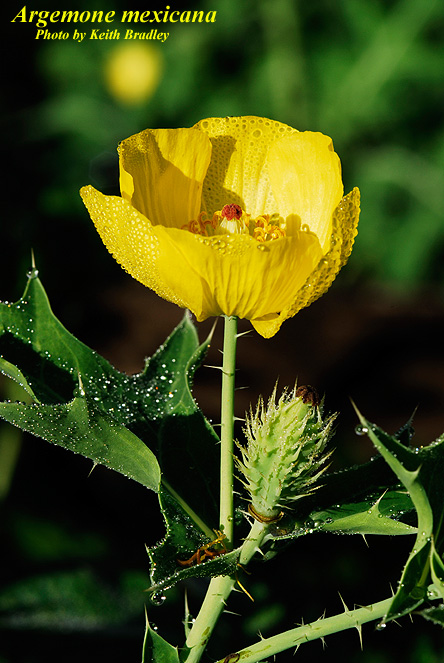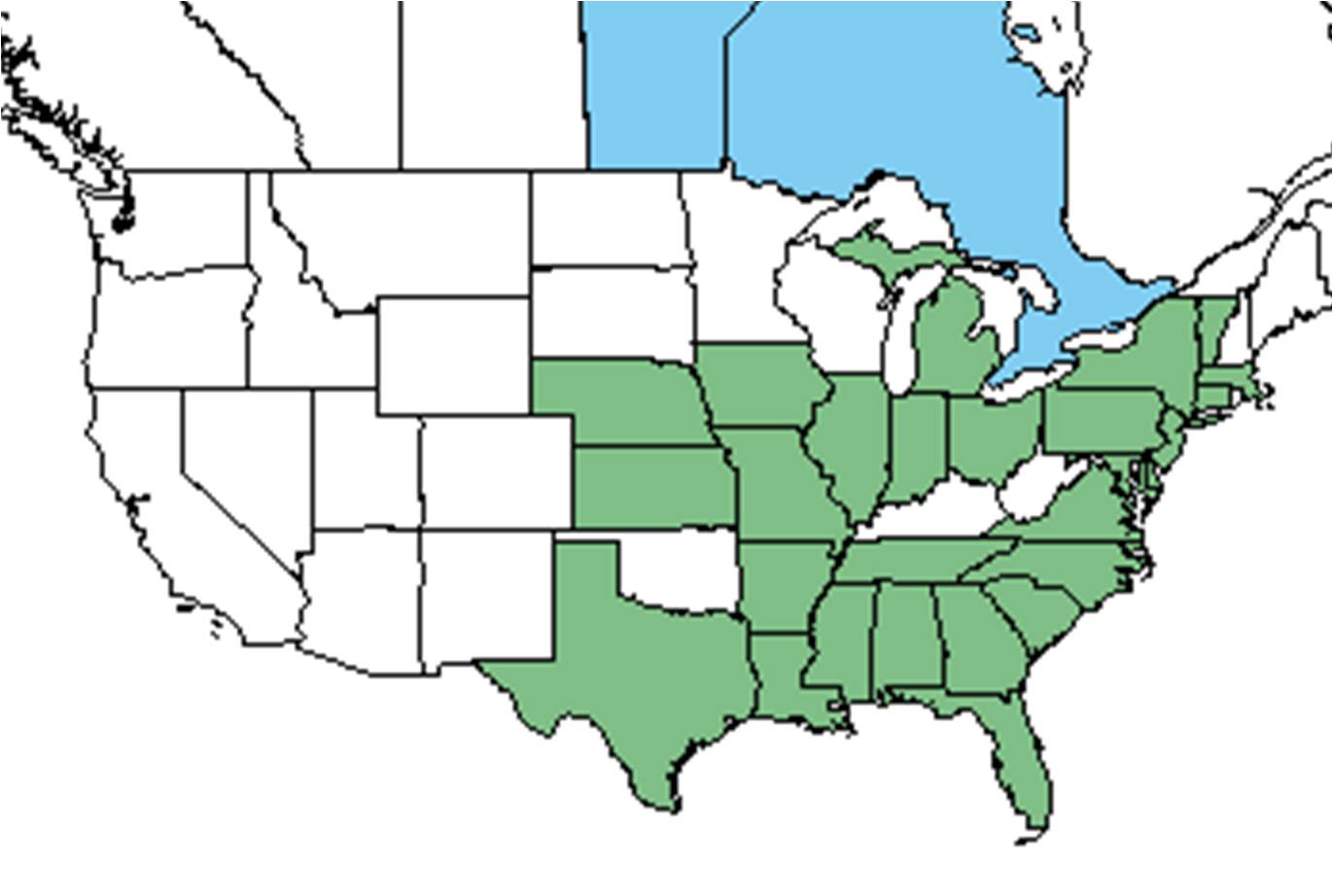Difference between revisions of "Argemone mexicana"
(→Distribution) |
HaleighJoM (talk | contribs) (→Ecology) |
||
| (4 intermediate revisions by 2 users not shown) | |||
| Line 28: | Line 28: | ||
==Distribution== | ==Distribution== | ||
| − | It is found across the southeast from peninsular Florida<ref name="Weakley">Weakley, Alan S. Flora of the Southern and Mid-Atlantic States: Working Draft of 21 May 2015. University of North Carolina Herbarium (NCU). PDF. 464.</ref> | + | It is found across the southeast from peninsular Florida<ref name="Weakley">Weakley, Alan S. Flora of the Southern and Mid-Atlantic States: Working Draft of 21 May 2015. University of North Carolina Herbarium (NCU). PDF. 464.</ref>, north to Pennsylvania, and west to Arizona. It is also found in Hawaii.<ref> Hardin, J.W., Arena, J.M. 1969. Human Poisoning from Native and Cultivated Plants. Duke University Press, Durham, North Carolina.</ref> |
| − | , north to Pennsylvania, and west to Arizona. It is also found in Hawaii.<ref> Hardin, J.W., Arena, J.M. 1969. Human Poisoning from Native and Cultivated Plants. Duke University Press, Durham, North Carolina.</ref> | ||
==Ecology== | ==Ecology== | ||
| Line 35: | Line 34: | ||
In the Coastal Plain, ''A. mexicana'' can be found in loamy soils of mesic woodlands and in disturbed areas, such as sandy roadsides and citrus groves.<ref>Florida State University Robert K. Godfrey Herbarium database. URL: [http://herbarium.bio.fsu.edu http://herbarium.bio.fsu.edu]. Last accessed: October 2015. Collectors: Loran C. Anderson, Leon Neel, R.A. Norris, Cecil R. Slaughter. States and Counties: Florida: Leon, Jackson, Polk. Georgia: Thomas. Compiled by Tall Timbers Research Station and Land Conservancy.</ref><ref name="Weakley"></ref> It is native to peninsular Florida.<ref name="Weakley"></ref> | In the Coastal Plain, ''A. mexicana'' can be found in loamy soils of mesic woodlands and in disturbed areas, such as sandy roadsides and citrus groves.<ref>Florida State University Robert K. Godfrey Herbarium database. URL: [http://herbarium.bio.fsu.edu http://herbarium.bio.fsu.edu]. Last accessed: October 2015. Collectors: Loran C. Anderson, Leon Neel, R.A. Norris, Cecil R. Slaughter. States and Counties: Florida: Leon, Jackson, Polk. Georgia: Thomas. Compiled by Tall Timbers Research Station and Land Conservancy.</ref><ref name="Weakley"></ref> It is native to peninsular Florida.<ref name="Weakley"></ref> | ||
| − | ===Phenology===<!--Timing off flowering, fruiting | + | ===Phenology===<!--Timing off flowering, fruiting, and environmental triggers. Cite PanFlora website if appropriate: http://www.gilnelson.com/PanFlora/ --> |
It flowers from April to May, and sometimes in August.<ref name="Weakley"></ref><ref>Nelson, G. [http://www.gilnelson.com/ PanFlora]: Plant data for the eastern United States with emphasis on the Southeastern Coastal Plains, Florida, and the Florida Panhandle. www.gilnelson.com/PanFlora/ Accessed: 19 MAY 2021</ref> | It flowers from April to May, and sometimes in August.<ref name="Weakley"></ref><ref>Nelson, G. [http://www.gilnelson.com/ PanFlora]: Plant data for the eastern United States with emphasis on the Southeastern Coastal Plains, Florida, and the Florida Panhandle. www.gilnelson.com/PanFlora/ Accessed: 19 MAY 2021</ref> | ||
| + | |||
<!--===Seed dispersal===--> | <!--===Seed dispersal===--> | ||
<!--===Seed bank and germination===--> | <!--===Seed bank and germination===--> | ||
| Line 42: | Line 42: | ||
===Pollination=== | ===Pollination=== | ||
| − | + | ''Argemone mexicana'' has been observed at the Archbold Biological Station with bees such as ''Apis mellifera'' (family Apidae) and sweat bees from the Halictidae family such as ''Halictus poeyi'' and ''Lasioglossum puteulanum''.<ref>Deyrup, M.A. 2015. Database of observations of Hymenoptera visitations to flowers of plants on Archbold Biological Station, Florida, USA.</ref> | |
| − | |||
| − | |||
| − | |||
| − | |||
| − | + | <!--===Herbivory and toxicology===--> | |
| − | <!--=== | ||
<!--===Diseases and parasites===--> | <!--===Diseases and parasites===--> | ||
==Conservation, cultivation, and restoration== | ==Conservation, cultivation, and restoration== | ||
| + | The plant is commonly found as a weed in livestock fields and cereal grains, and is dangerous even in low doses to poultry.<ref> Burrows, G.E., Tyrl, R.J. 2001. Toxic Plants of North America. Iowa State Press.</ref> | ||
==Cultural use== | ==Cultural use== | ||
| + | The plant is considered poisonous, but is not usually a problem except in cases of the seeds mixing into homegrown corn, oats, and wheat. Ingesting the seeds or leaves can cause a variety of severe symptoms including bodily swelling, fainting, and coma.<ref> Hardin, J.W., Arena, J.M. 1969. Human Poisoning from Native and Cultivated Plants. Duke University Press, Durham, North Carolina.</ref> | ||
| + | |||
==Photo Gallery== | ==Photo Gallery== | ||
<gallery widths=180px> | <gallery widths=180px> | ||
Latest revision as of 18:39, 15 June 2022
Common names: Mexican pricklypoppy; Mexican poppy
| Argemone mexicana | |
|---|---|

| |
| Photo by Keith Bradley, Atlas of Florida Vascular Plants | |
| Scientific classification | |
| Kingdom: | Plantae |
| Division: | Magnoliophyta - Flowering plants |
| Class: | Magnoliopsida - Dicotyledons |
| Order: | Papaverales |
| Family: | Papaveraceae |
| Genus: | Argemone |
| Species: | A. mexicana |
| Binomial name | |
| Argemone mexicana L. | |

| |
| Natural range of Argemone mexicana from USDA NRCS Plants Database. | |
Contents
Taxonomic notes
Synonym: none.[1]
Varieties: none.[1]
Description
A description of Argemone mexicana is provided in The Flora of North America.
Distribution
It is found across the southeast from peninsular Florida[2], north to Pennsylvania, and west to Arizona. It is also found in Hawaii.[3]
Ecology
Habitat
In the Coastal Plain, A. mexicana can be found in loamy soils of mesic woodlands and in disturbed areas, such as sandy roadsides and citrus groves.[4][2] It is native to peninsular Florida.[2]
Phenology
It flowers from April to May, and sometimes in August.[2][5]
Pollination
Argemone mexicana has been observed at the Archbold Biological Station with bees such as Apis mellifera (family Apidae) and sweat bees from the Halictidae family such as Halictus poeyi and Lasioglossum puteulanum.[6]
Conservation, cultivation, and restoration
The plant is commonly found as a weed in livestock fields and cereal grains, and is dangerous even in low doses to poultry.[7]
Cultural use
The plant is considered poisonous, but is not usually a problem except in cases of the seeds mixing into homegrown corn, oats, and wheat. Ingesting the seeds or leaves can cause a variety of severe symptoms including bodily swelling, fainting, and coma.[8]
Photo Gallery
References and notes
- ↑ 1.0 1.1 Weakley, A.S. 2015. Flora of the southern and mid-atlantic states. Working Draft of 21 May 2015. University of North Carolina at Chapel Hill, Chapel Hill, North Carolina.
- ↑ 2.0 2.1 2.2 2.3 Weakley, Alan S. Flora of the Southern and Mid-Atlantic States: Working Draft of 21 May 2015. University of North Carolina Herbarium (NCU). PDF. 464.
- ↑ Hardin, J.W., Arena, J.M. 1969. Human Poisoning from Native and Cultivated Plants. Duke University Press, Durham, North Carolina.
- ↑ Florida State University Robert K. Godfrey Herbarium database. URL: http://herbarium.bio.fsu.edu. Last accessed: October 2015. Collectors: Loran C. Anderson, Leon Neel, R.A. Norris, Cecil R. Slaughter. States and Counties: Florida: Leon, Jackson, Polk. Georgia: Thomas. Compiled by Tall Timbers Research Station and Land Conservancy.
- ↑ Nelson, G. PanFlora: Plant data for the eastern United States with emphasis on the Southeastern Coastal Plains, Florida, and the Florida Panhandle. www.gilnelson.com/PanFlora/ Accessed: 19 MAY 2021
- ↑ Deyrup, M.A. 2015. Database of observations of Hymenoptera visitations to flowers of plants on Archbold Biological Station, Florida, USA.
- ↑ Burrows, G.E., Tyrl, R.J. 2001. Toxic Plants of North America. Iowa State Press.
- ↑ Hardin, J.W., Arena, J.M. 1969. Human Poisoning from Native and Cultivated Plants. Duke University Press, Durham, North Carolina.